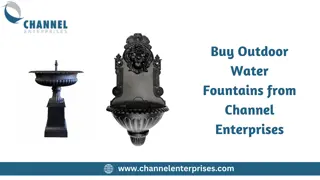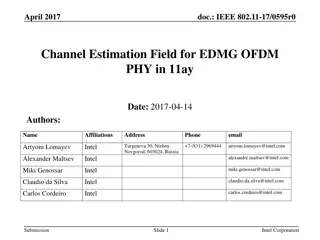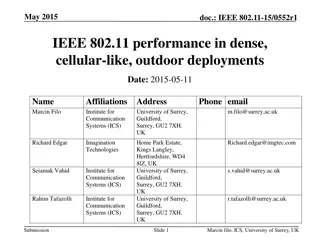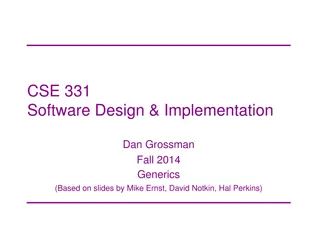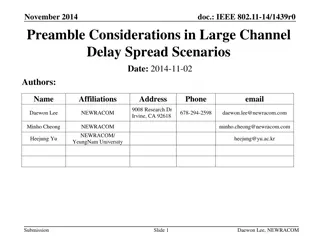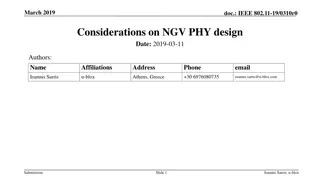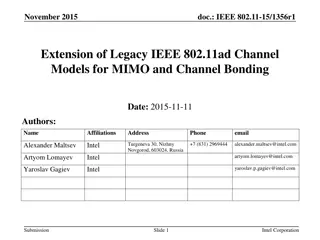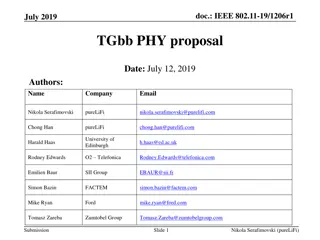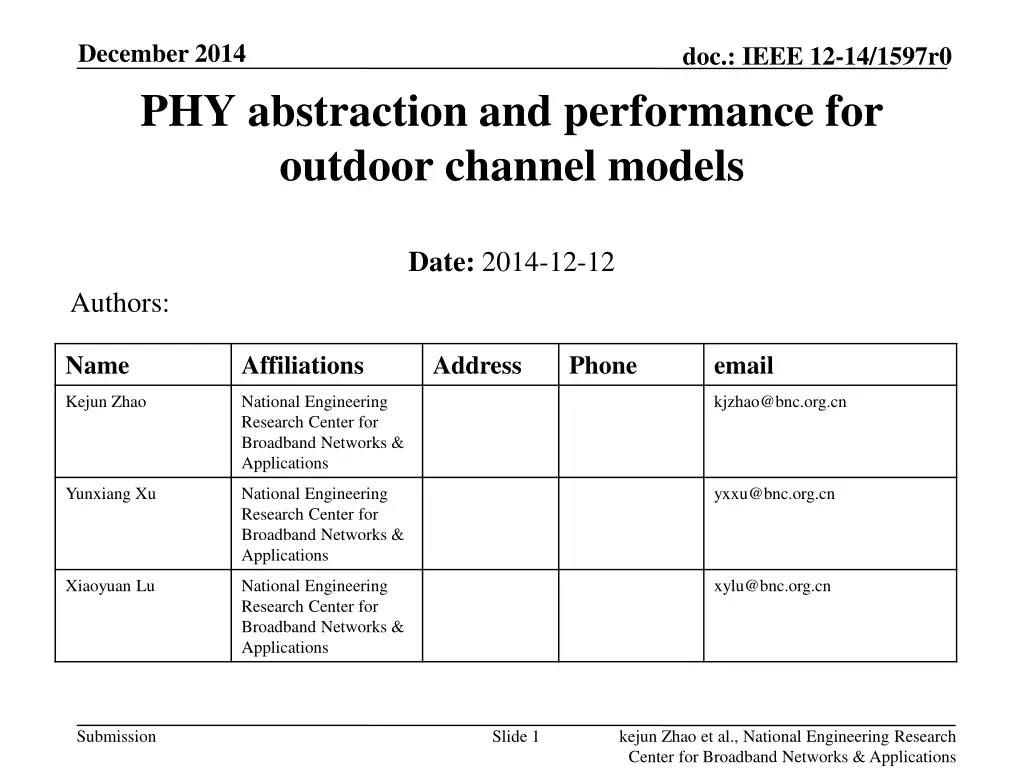
December 2014 PHY Abstraction and Performance for Outdoor Channel Models
Enhance your understanding of PHY abstraction for outdoor channel models as presented in the December 2014 IEEE document (12-14/1597r0). Explore suggestions for outdoor channels and SNR to PER performance curves, emphasizing the importance of evaluating outdoor propagation environments in TGax evaluations. Discover key insights and recommendations for achieving PHY abstraction for fading channels and utilizing outdoor channel models in simulation settings.
Download Presentation

Please find below an Image/Link to download the presentation.
The content on the website is provided AS IS for your information and personal use only. It may not be sold, licensed, or shared on other websites without obtaining consent from the author. If you encounter any issues during the download, it is possible that the publisher has removed the file from their server.
You are allowed to download the files provided on this website for personal or commercial use, subject to the condition that they are used lawfully. All files are the property of their respective owners.
The content on the website is provided AS IS for your information and personal use only. It may not be sold, licensed, or shared on other websites without obtaining consent from the author.
E N D
Presentation Transcript
December 2014 PHY abstraction and performance for outdoor channel models doc.: IEEE 12-14/1597r0 Date: 2014-12-12 Authors: Name Affiliations Address Phone email Kejun Zhao National Engineering Research Center for Broadband Networks & Applications kjzhao@bnc.org.cn Yunxiang Xu National Engineering Research Center for Broadband Networks & Applications yxxu@bnc.org.cn Xiaoyuan Lu National Engineering Research Center for Broadband Networks & Applications xylu@bnc.org.cn Submission Slide 1 kejun Zhao et al., National Engineering Research Center for Broadband Networks & Applications
December 2014 doc.: IEEE 12-14/1597r0 Abstract PHY abstraction for outdoor channel models is necessary to be considered in Box0. In this presentation, we provide our suggestions for outdoor channels and the SNR to PER performance curves as well. Submission Slide 2 kejun Zhao et al., National Engineering Research Center for Broadband Networks & Applications
December 2014 doc.: IEEE 12-14/1597r0 Introduction Box0 in TGax evaluation methodology [1] mainly focuses on PHY abstraction for indoor channels, including 11n_B and 11n_D. Outdoor propagation environments, in which TGax PAR [2] requires to increase robustness, are also very important and necessary to be studied for the TGax group. PHY abstraction for outdoor channels is considerable to be an additional evaluation in Box0. In this presentation, we will give some suggestions on PHY abstraction for outdoor channels and provide our SNR to PER performance curves. Submission Slide 3 kejun Zhao et al., National Engineering Research Center for Broadband Networks & Applications
December 2014 doc.: IEEE 12-14/1597r0 Suggestions on PHY abstraction for outdoor channels Basically, we can obtain PHY abstraction for outdoor fading channels with the same evaluation methods as indoor fading channels, except that outdoor channel models should be used in PHY simulation. ITU-R UMi and UMa are the two agreed TGax outdoor scenario channel models [3]. Thus, four channel types, namely UMi_LOS, UMi_NLOS, UMa_LOS, UMa_NLOS, can be considered. Moreover, for each channel type, we suggest to simulator over a range of SNR in 1dB steps down to 1% PER or 40dB whichever comes first for each MCS because SINR is usually smaller than 40dB in outdoor scenario SS4 measured by [4]. Submission Slide 4 kejun Zhao et al., National Engineering Research Center for Broadband Networks & Applications
December 2014 doc.: IEEE 12-14/1597r0 Basic setting in PHY simulation of outdoor channel models Basic settings 20MHz BW Channel model UMi_LOS, UMi_NLOS, UMa_LOS, UMa_NLOS number of spatial stream GI Packet size code MCS Timing and frequency synchronization Channel estimation 1 Long (800ns) 32 Bytes BCC 0, 1, 2, 3, 4, 5, 6, 7, 8 Perfect L-MMSE For each channel type, simulator over 100 channel realizations For each channel realizations, simulator over 1000 packets and for each packet decide if it has been successfully received by directly comparing the transmitted PPDU and received PPDU. Submission Slide 5 kejun Zhao et al., National Engineering Research Center for Broadband Networks & Applications
December 2014 doc.: IEEE 12-14/1597r0 The SNR vs. PER performance cures in UMi LOS channel(1/2) Submission Slide 6 kejun Zhao et al., National Engineering Research Center for Broadband Networks & Applications
December 2014 doc.: IEEE 12-14/1597r0 The SNR vs. PER performance cures in UMi LOS channel(2/2) From the simulation result above, the performance in UMi LOS channel is much worse than indoor channels [5]. For MCS = 0, 48.00% users can keep the PER lower than 1% only when SNR is higher than 5dB. For MCS = 8, 46.00% users can keep the PER lower than 1% only when SNR is higher than 30dB. 10.00% users even can not keep the PER lower than 1%. We think one of the main reasons is the existence of excess delay spread larger than 800ns in outdoor channel models which was proposed by [6]. Among those 48.00% users for MCS = 0, 77.08% of them have excess delay spread larger than 800ns. Among those 46.00% users for MCS = 8, 82.61% of them have excess delay spread larger than 800ns. Inter symbol interference results in increase in PER and cannot be resolved using a single tap equalization [6]. Slide 7 Submission kejun Zhao et al., National Engineering Research Center for Broadband Networks & Applications
December 2014 doc.: IEEE 12-14/1597r0 The SNR vs. PER performance cures in UMi NLOS channel From the figure, the performance for UMi NLOS is worse than UMi LOS. For MCS = 0, 51.65% users need SNR higher than 10dB and 1.10% users cannot reach 1% PER, where 70.21% of them have excess delay spread larger than 800ns. For MCS = 8, 64.84% need SNR higher than 35dB and 39.56% users cannot reach 1% PER, where 74.58% of them have excess delay spread larger than 800ns. Submission Slide 8 kejun Zhao et al., National Engineering Research Center for Broadband Networks & Applications
December 2014 doc.: IEEE 12-14/1597r0 The SNR vs. PER performance cures in UMa LOS channel Statistically, for MCS = 0, 56.00% users need SNR higher than 5dB, where 83.93% of them have excess delay spread larger than 800ns. For MCS = 8, 55.00% users need SNR higher than 30dB and 33.00% users cannot reach 1% PER, where 92.73% of them have excess delay spread larger than 800ns. . Submission Slide 9 kejun Zhao et al., National Engineering Research Center for Broadband Networks & Applications
December 2014 doc.: IEEE 12-14/1597r0 The SNR vs. PER performance cures in UMa NLOS channel From the figure, the performance for UMa NLOS is also much worse than UMa LOS. For MCS = 0, 81.97% users need SNR higher than 10dB and 14.75% users cannot reach 10% PER, where 98.00% of them have excess delay spread larger than 800ns. For MCS = 8, 91.80% users cannot reach 10% PER, where 98.28% of them have excess delay spread larger than 800ns. Submission Slide 10 kejun Zhao et al., National Engineering Research Center for Broadband Networks & Applications
December 2014 doc.: IEEE 12-14/1597r0 Summary We suggest to add PHY abstraction for outdoor channel models in Box0, where UMi and UMa channel models can be considered. The SNR to PER performance curves are given. The results show that the performance in UMi and UMa channels is far from TGax requirements, especially in NLOS environments due to excess delay spread larger than 800ns. Large channel delay in outdoor scenarios will be one of challenges for the TGax group. Submission Slide 11 kejun Zhao et al., National Engineering Research Center for Broadband Networks & Applications
December 2014 doc.: IEEE 12-14/1597r0 References [1] 11-14-0571-06-00ax-evaluation-methodology [2] 11-14-0165-01-0hew-802-11-hew-sg-proposed-par [3] 11-14-0980-05-00ax-simulation-scenarios [4] 11-14-0800-28-00ax-box-1-and-box-2-calibration- results [5] 11-14-0873-03-00ax-discussion-on-phy-abstraction-for- 11ax-system-level-simulation [6] 11-14-1439-00-00ax-preamble-considerations-in-large- channel-delay-spread-scenarios Submission Slide 12 kejun Zhao et al., National Engineering Research Center for Broadband Networks & Applications



